Sharp’s capable large-room purifier uses a two-prong approach to eliminate pollutants, but it suffers from a complicated, buggy setup.
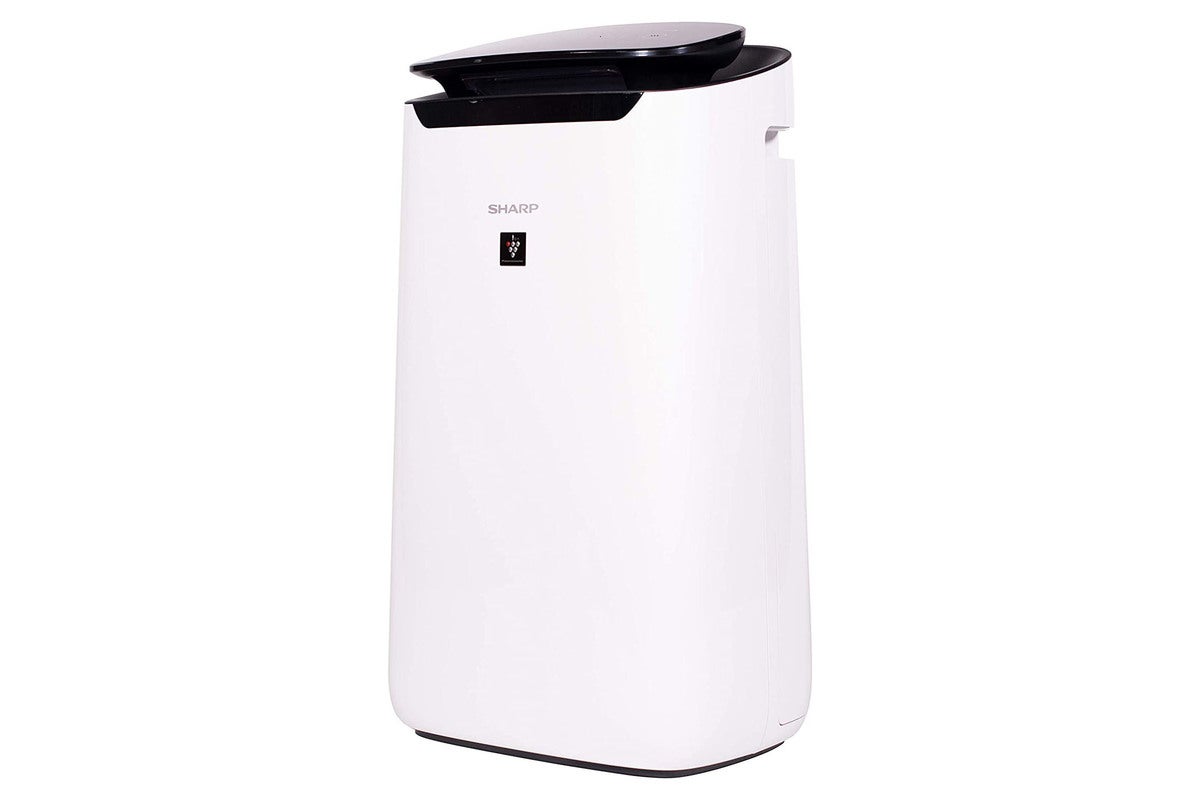
Sharp
Today’s Best Tech Deals
Picked by TechHive’s Editors
Top Deals On Great Products
Picked by Techconnect’s Editors
Sharp FXJ80UW Air Purifier
Indoor air quality has taken on heightened importance during the COVID-19 pandemic. Studies consistently show that air inside homes is worse than the air outside, so being homebound potentially increases the risks of allergic reactions or of exacerbating conditions like asthma. The Sharp FXJ80UW air purifier aims to have you breathing easier—literally and figuratively—with a two-pronged approach to eliminating common airborne allergens as well as bacteria, viruses, and mold. But while it’s packed with solid features and technology, it can often feel complicated to operate.
The FXJ80UW is a big air purifier for big rooms. Designed to clean the air in rooms up to 502 square feet, the unit measures 28.7 x 16.4 x 11.5 inches (HxWxD) and weighs 23.8 pounds. An appliance of this size will be noticeable wherever you put it, so the best you can hope for is that it doesn’t drag down your décor with an ugly industrial look. The FXJ80UW succeeds at this with a simple design that puts most of the buttons and settings on the top panel, where they’re out of sight until you’re standing right over it.
That panel includes everything you need operate the air purifier, including the power button and controls to adjust the fan speed, cleaning modes, and the front display. There’s also a button here to lock the panel, so no one can change your settings. Beneath the panel on the front of the unit is an air quality monitor light that changes color on a spectrum of blue to red to indicate the “air purity” of the room. At the extreme ends, blue means everything is great and red means it’s probably past time to open some windows.
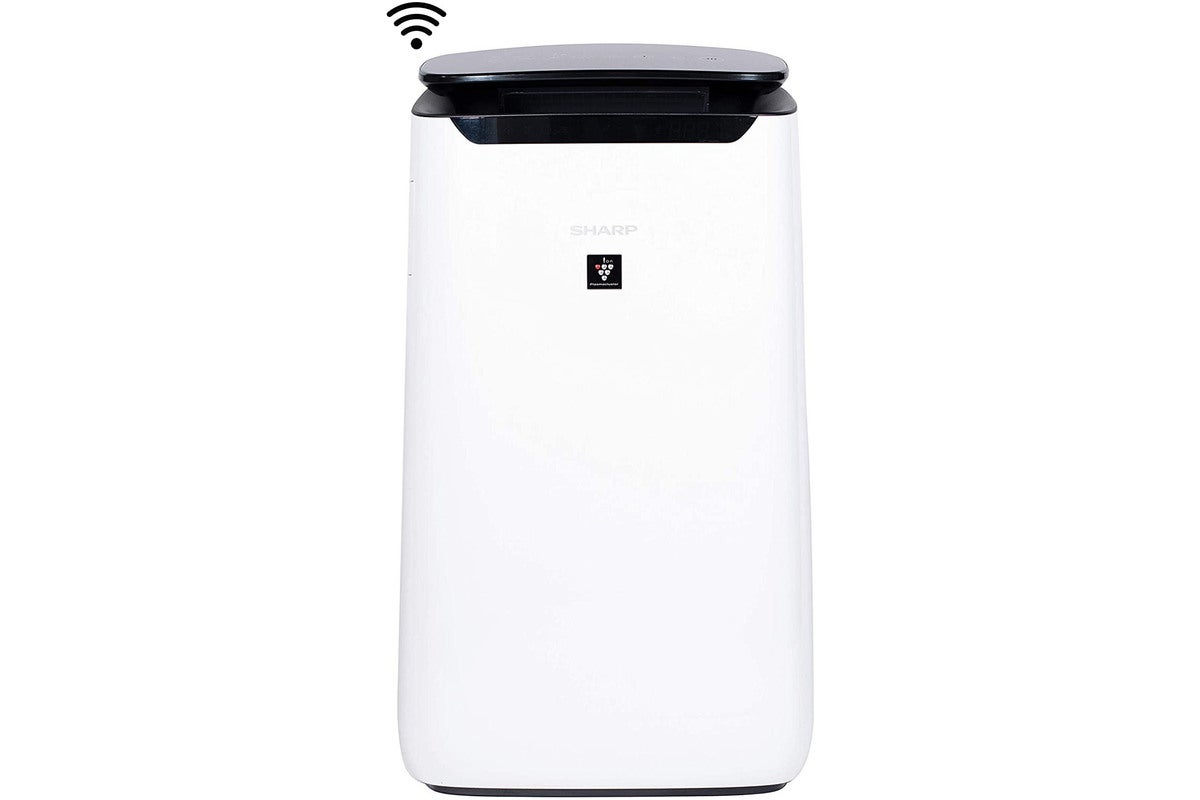 Sharp
SharpThe FXJ80UW is a big purifier for big rooms—it can clean the air in spaces up to 502 square feet.
The front display under this light provides greater detail about your indoor air quality, including changes in the levels of dust, odor, PM2.5 (particles smaller than 2.5 microns), temperature, and humidity. It can also tell you how much power the unit is consuming by the unit, when the filter needs to be replaced, and how much time is remaining when using the timer setting. There are enough functions and settings to recommend you hold on to the user manual until you get familiar with them all.
The FXJ80UW uses a two-step process to clean your air—HEPA filtration and Sharp’s Plasmacluster Ion Technology. The first passes air through a pre-filter to trap dust and other large particles, then through an active carbon deodorizing filter, and finally a HEPA filter that’s certified to capture 99.97 percent of particles small as 0.3 microns.
The Plasmacluster technology uses a Plasmacluster Ion-Generating Unit on the side of the machine to split water molecules into positively and negatively charged ions that are diffused throughout the room to breakdown germs, bacteria, fungus, mold, viruses and other pollutants, and then return to the air as water vapor. Sharp says this technology reduced 94 percent of E.coli bacteria, 84.3 percent of Staphylococcus Epidermidis, and 87.7 percent of Penicillium Citrinum, a common mold, during testing in in a closed laboratory over a four-hour period.
The purifier has a Clean Air Delivery Rate (CADR) of 334 cubic feet per minute (CFM) for dust, 324 CFM for smoke, and 361 CFM for pollen. CADR reflects the purifier’s effectiveness at removing indoor air pollutants based on room size and the volume of clean air produced per minute. Generally, the higher the CADR number, the more effective the purifier is.
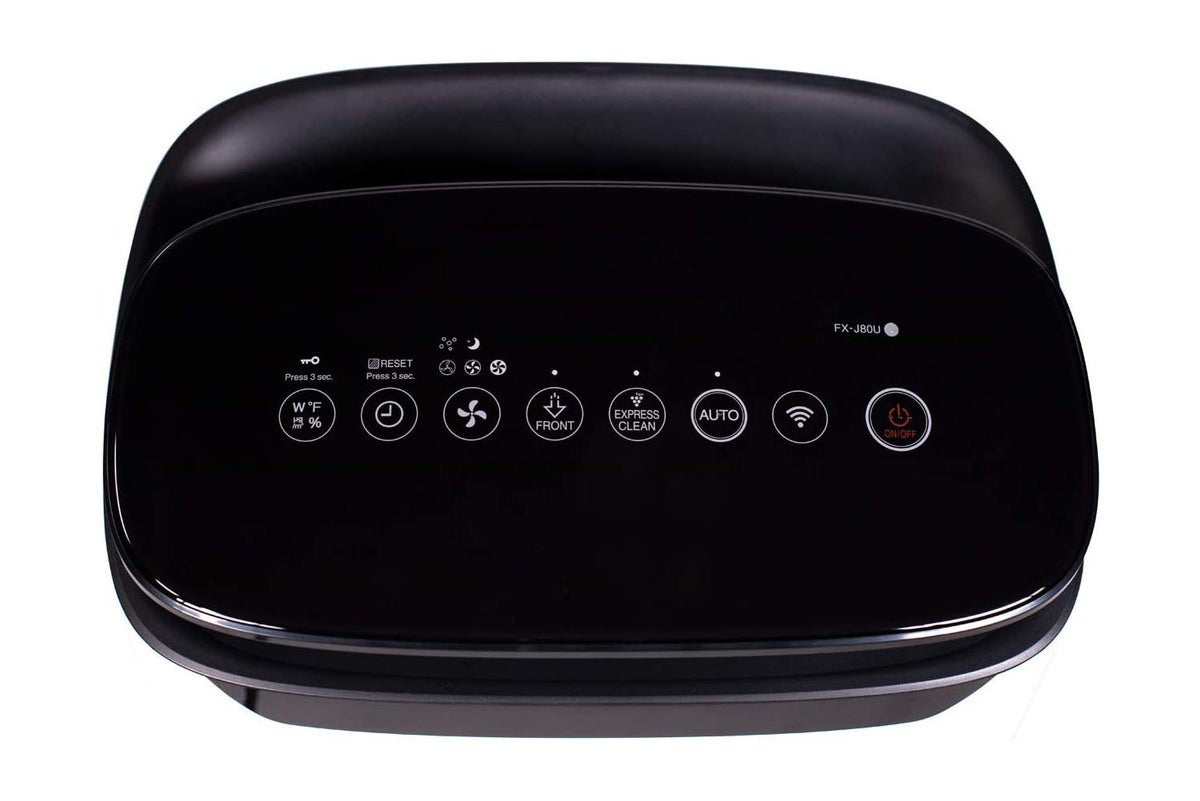 Sharp
SharpYou can control various features and functions by using the buttons on the control panel in various combinations, so don’t throw out he user manual.
The FXJ80UW includes Amazon Alexa support and enables voice commands for turning the purifier on and off as well as activating its various cleaning modes.
Setup and performance
Before using the air purifier, you must pull off the back panel, remove the filters, take them out of their plastic bags, then reinstall them in the correct order. That done, you’ll replace the back panel, plug the unit in, and turn it on.
You can operate the FXJ80UW from its control panel or remotely with the Sharp Air app for iOS and Android. The app requires you create an account and pair the purifier with your mobile device. That’s usually a straightforward process, but this one was more complex and finicky than most.
When you first log into the app and select the pairing option from the menu, you’re presented with two options: one for routers that have a Wi-Fi Protected Setup (WPS) button and another for routers that don’t. If your router has a WPS button, you just need to press the Wi-Fi button on the FXJ80UW for three seconds until the Wi-Fi indicator on the display blinks, then press the WPS button on your router again and the connection should be complete.
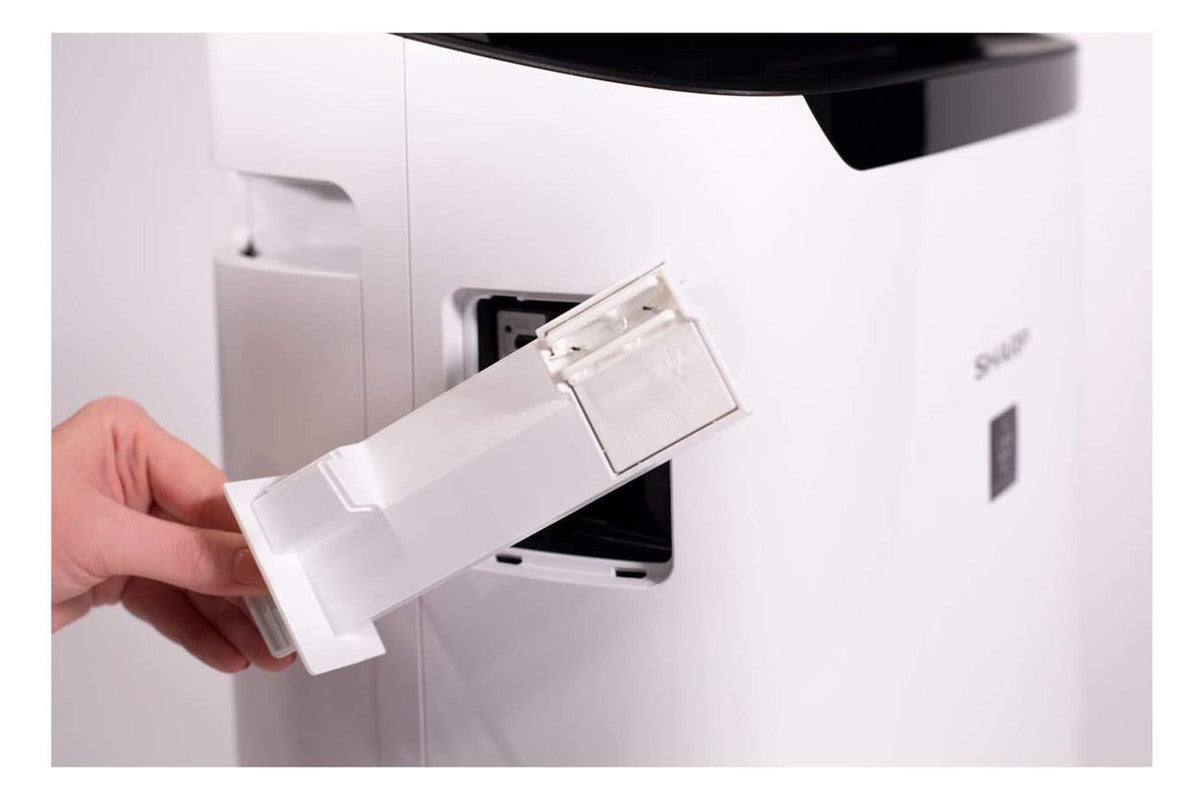 Sharp
SharpA Plasmacluster Ion-Generating Unit on the side of the machine splits water molecules into positively and negatively charged ions that break down bacteria, viruses, mold, and other airborne pollutants.
If your router does not have a WPS button, as mine doesn’t, you must complete two setups—the first to connect the purifier to your router and the second to pair your device to the purifier. Connecting the purifier to your router comprises nearly a dozen steps using combinations of control panel buttons to activate various settings. Once the Wi-Fi connection is established, there are a half-dozen more steps to pair your phone. I experienced issues at several steps during the purifier-to-router setup, including dropped connections and the purifier not appearing as a connectable device in my Wi-Fi settings.
Even when I did successfully connect the purifier to the router, I couldn’t get the purifier to pair with my device. Each time I’d get through the process, the established Wi-Fi connection would be lost, and the app would return all the way back to the beginning of the Wi-Fi setup. After more than a dozen fruitless attempts, which took about 40 minutes because of the number of steps involved, I had to admit defeat.
That’s too bad because in addition to offering remote control of the purifier and access to your air quality data, connecting the FXJ80UW to your W-Fi network allows you to enable Sharp Cloud, a feature that automatically adjusts the purifier’s sensitivity settings based on your usage history. That allows the purifier to optimize its performance in Auto mode.
App connection problems aside, the FXJ80UW performed well. In Auto mode, the purifier consistently recognized changes in air quality, such as when I was cooking or dusting. At these times, the air quality monitor light would turn red, and the fan speed would increase. After a few moments, the fan would return to a slower speed and the light would shift back toward blue.
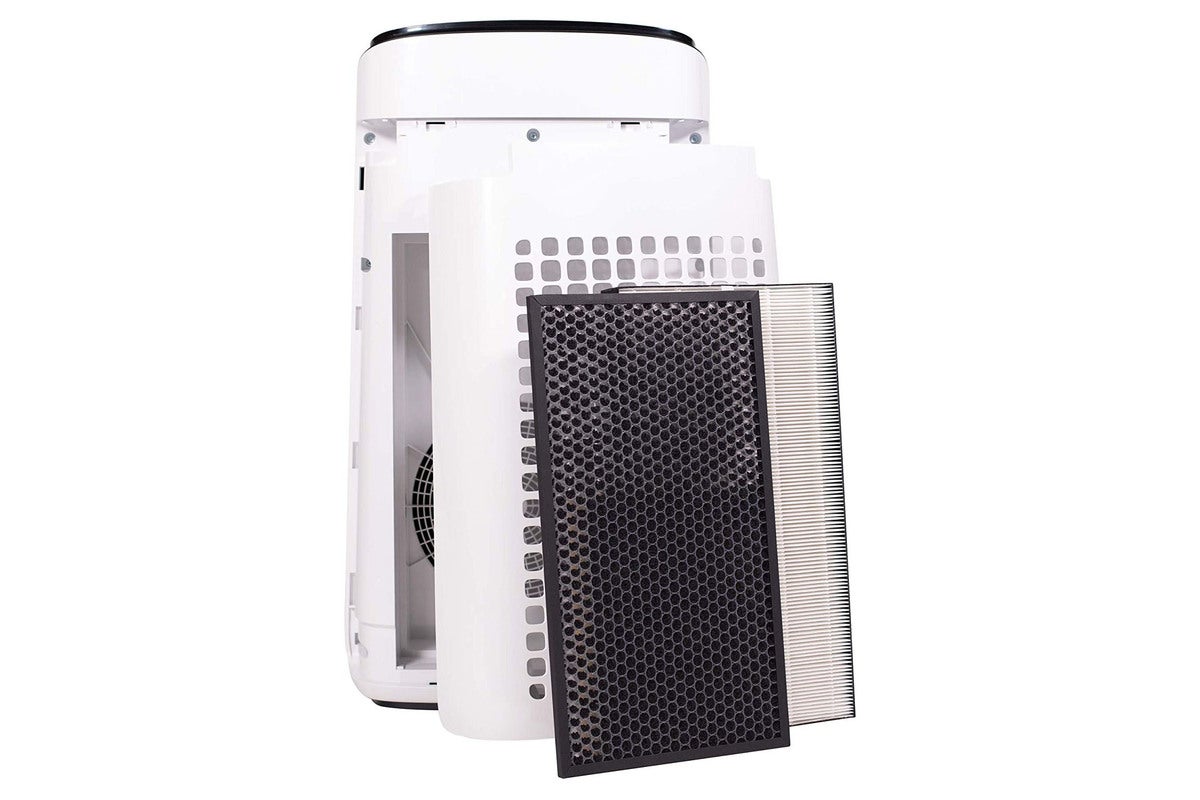 Sharp
SharpThe purifier uses HEPA filtration to capture common allergens.
In addition to Auto mode, the purifier also offers three manual fan speeds—Low, Medium, and Max—as well as a Pollen mode that increases the dust sensor sensitivity to more quickly detect dust and pollen, and a Sleep mode that reduces operation noise and dims or turns off the display and air quality monitor light based on the ambient light in the room.
Plasmacluster Ion Technology is easily activated or deactivated by pressing in the fan speed button for three seconds. There’s also a dedicated button for Plasmacluster Express Clean Mode, which essentially activates the technology to clean the air for one hour before automatically returning to the previous operation mode, and one for Plasmacluster Spot Mode that removes odor and germs from furniture or clothing placed in front of the purifier.
Customizing what information you want to see on the display, using the timer function, and assigning and changing functions are easy to do once you get the hang of it; but here again, the user manual is indispensable as adjusting most of these settings requires multiple steps using different combinations of controls. It’s not likely you’ll remember many of these on your own, particularly if you don’t change them very often.
Verdict
The FXJ80UW performed well during my daily usage. It consistently responded quickly to changes in air quality, and its temperature and humidity readings matched those on the indoor thermometer/hygrometer I use in the same room. The large air quality monitor light was great for getting at-a-glance status reports from anywhere on my downstairs level. And the purifier is easily the quietest I’ve ever used; in the first few days of use, I often had to walk right up to it to assure myself it was running.
But the complexity and bugginess of the Wi-Fi connection and device pairing process were definite downers. And I was often overwhelmed by this device’s sheer number of buttons, modes, and functions and found myself repeatedly consulting the instruction manual. While not deal-breakers, these are things to seriously consider given the FXJ80UW’s $600 price tag, plus the likely annual replacement of the filters. For the same price, the NuWave OxyPure Smart Air Purifier can clean the air of a space as large as 1,200 square feet—more than double the max size the FXJ80UW can cover—and offers much more intuitive control. The FXJ80UW is capable, but it’s worth shopping around before you commit.
Note: When you purchase something after clicking links in our articles, we may earn a small commission. Read our affiliate link policy for more details.
Sharp FXJ80UW Air Purifier
The Sharp FXJ80UW is a high-performing, Wi-Fi-enabled air purifier, but it has a considerable learning curve and its set up process is complex and finicky.
Pros
- Extremely quiet
- Real-time air quality monitoring
- Automatically adjusts fan speed to match air quality
Cons
- Complicated Wi-Fi setup
- A plethora of features and functions leads to a steep learning curve
- Buggy setup process
Michael Ansaldo is a veteran consumer and small-business technology journalist. He contributes regularly to TechHive and writes the Max Productivity column for PCWorld.

